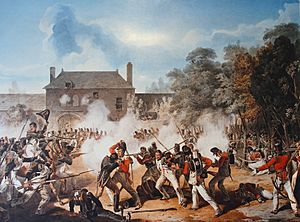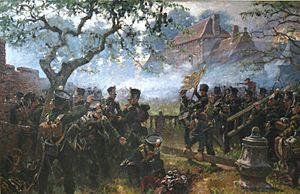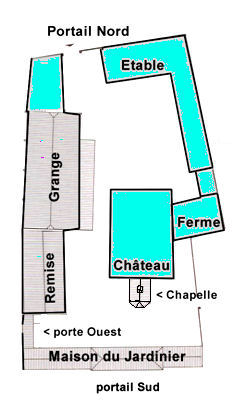Hougoumont facts for kids
Quick facts for kids Château d'Hougoumont |
|
|---|---|
| Waterloo, Belgium | |

View of the Hougoumont farm from the south, showing the restored Game Keeper's Cottage and the gate on that side
|
|
| Site information | |
| Owner | Intercommunal cooperative society "Bataille de Waterloo 1815" |
| Condition | under reconstruction |
| Site history | |
| Built | Between 1358 and 1474 |
| Built by | Order of St. John of Jerusalem (the Knights of Malta) |
| Materials | sandstone and red brick |
| Battles/wars | Battle of Waterloo |
| Garrison information | |
| Occupants |
|
Château d'Hougoumont is a historic farm and estate near Waterloo, Belgium. It's a large, walled property that played a super important role in the Battle of Waterloo on June 18, 1815. During this famous battle, the Anglo-allied army, led by the Duke of Wellington, defended Hougoumont against Napoleon's army.
The farm was badly damaged during the battle. Luckily, it was fully restored and opened to the public on June 18, 2015. This was just in time for the 200th anniversary of the Battle of Waterloo.
Contents
What's in a Name? The Story of Hougoumont
The name "Hougoumont" first appeared on a map in 1777. Before that, it was called "Chateau Goumont." This name was first written down in 1358.
Some people think the name "Hougoumont" was a mistake. Sir Walter Scott, a famous writer, visited the battlefield in 1816. He believed the Duke of Wellington might have accidentally used the wrong name. But even if it was a mistake, the name "Hougoumont" stuck!
A Look Back: The History of Hougoumont
The land where Hougoumont stands was bought in 1474. The buyers were the Knights Hospitaller, a group of knights. They later became known as the Order of Malta. At that time, there wasn't a building on the land.
A building was built later and sold in 1536. Over the years, different families owned the estate. The current building was built around the 1600s.
By 1815, the owner was Ridder de Louville. He didn't live there, so Antoine Dumonceau managed the farm. Dumonceau created a beautiful French formal garden at Hougoumont. After the battle, the farm was sold to François de Robiano. It needed many repairs.
Eventually, the d'Oultremont family owned the estate. In 2003, they sold it to a Belgian group. This group, called "Bataille de Waterloo 1815," now owns and cares for the historic site.
The Battle for Hougoumont: A Key Fight
In June 1815, Hougoumont became a major battleground. It was one of the first places where British and allied soldiers fought Napoleon's army.
June 1815: The Attack Begins
Napoleon's plan was to attack Hougoumont first. He hoped this would make Wellington send his reserve troops to defend it. Then, Napoleon would attack the center of Wellington's army.
Before the battle, allied soldiers made Hougoumont a strong fortress. Troops from Nassau and Hanover were there. British Coldstream Guards and Scots Guards also defended the farm and its gardens. Lieutenant-Colonel James Macdonell was in charge of all the troops at Hougoumont.
Wellington said Napoleon's attack on Hougoumont started around 10:00 AM. Other sources say it was closer to 11:30 AM. No one is completely sure when the battle actually began!
The French attacked the woods and park first. They were pushed back by strong British artillery fire. Then, a second French attack tried to break through the south side. They made a small hole but couldn't get through.
The Famous North Gate Fight
A more successful French attack happened on the north side. A French soldier named Sous-Lieutenant Legros used an axe. He managed to break through the north gate!
A fierce fight broke out inside the gate. French soldiers rushed in. But Macdonnell and a few other brave soldiers fought back. They managed to close the gate, trapping Legros and about 30 other French soldiers inside. All the French soldiers who entered, except for a young drummer boy, were killed in this hand-to-hand combat.
The British and German soldiers inside Hougoumont started running low on ammunition. A brave driver from the Royal Waggon Train drove an ammunition cart through French lines. He brought supplies to the troops, even though his horses were wounded.
Fighting continued all afternoon around Hougoumont. French light infantry and cavalry kept attacking.
Later in the afternoon, Napoleon himself ordered the house to be shelled. He wanted it to burn. Wellington saw the flames and sent a message to the commander. He told him to hold the position no matter what. Most of the house was destroyed by fire, except for the chapel.
More allied troops, including the King's German Legion and the 71st Foot (a Scottish regiment), came to help. They successfully fought off more French attacks. The allied forces held Hougoumont until the end of the battle.
Why Hougoumont Was So Important
Many people think the attack on Hougoumont was just a trick. Napoleon wanted to distract Wellington. But the fight for Hougoumont became a huge, all-day battle. It pulled in more and more French troops. This actually had the opposite effect of what Napoleon wanted!
Both Napoleon and Wellington thought Hougoumont was a very important part of the battle. Wellington later said that "the success of the battle turned upon the closing of the gates at Hougoumont."
Napoleon could see Hougoumont clearly from his position. He kept sending more and more troops there all afternoon. In total, 33 French battalions (about 14,000 soldiers) attacked Hougoumont.
Wellington also sent many troops to defend the house. He sent 21 battalions (about 12,000 soldiers) to keep the path to the house open. This allowed fresh troops and ammunition to get in. He even moved some of his artillery batteries to support Hougoumont.
The Mystery of the Wells
In his famous book Les Misérables, Victor Hugo wrote that 300 bodies were thrown into a well at Hougoumont. However, an archaeological dig in 1985 found no human remains in a well at the site. This suggests that Hugo's story might be a myth.
But, a diary from 1815 tells a different story. A tourist visited the battlefield a month after the battle. He was told that 73 men were found in a well at Hougoumont. So, while 300 might be an exaggeration, it's possible some bodies were indeed put into the wells.
Saving History: Restoration of Hougoumont
Hougoumont was a working farm until the late 1900s. In 2003, it became the property of the "1815" group. By 2006, the farm looked quite old and damaged. Its once white walls were dirty, and some parts were cracked.
A group called Project Hougoumont was created. They raised money to restore and protect Hougoumont for the future. The project finished in June 2015. It cost about £3 million (around $4 million USD).
On June 17, 2015, Charles, Prince of Wales (now King Charles III) unveiled a memorial at Hougoumont. This memorial honors the British soldiers who fought there. It shows two life-size soldiers trying to close the north gate. The next day, on the 200th anniversary of the battle, Hougoumont opened to the public.
Images for kids
See also
- Order of Battle of the Waterloo Campaign
- List of Waterloo Battlefield locations











